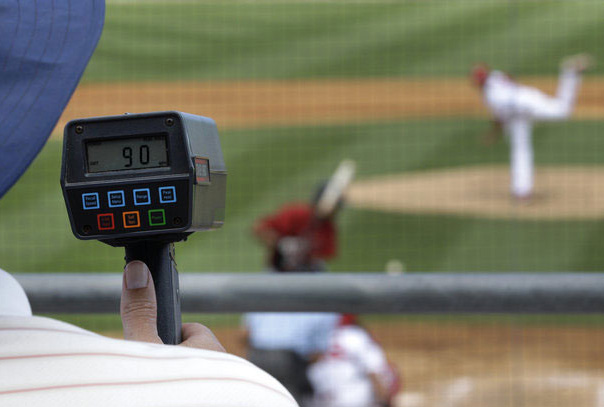 Entire books can and have been written about the importance and development of velocity training with baseball pitchers. We know that there are many different ways to improve velocity within the structure of a season. There are also a plethora of off-season training options that have velocity improvement as an end-goal. This has resulted in quite a slippery slope—more pitchers are throwing harder, and more pitchers are getting injured. And too much focus on velo and not enough on command, for example, can result in pitchers who are not able to “move the game” and prevent free bases, hitters counts and ultimately, runs scored and watchable baseball. Here are a few concepts that can allow coaches to monitor and improve velocity:
Entire books can and have been written about the importance and development of velocity training with baseball pitchers. We know that there are many different ways to improve velocity within the structure of a season. There are also a plethora of off-season training options that have velocity improvement as an end-goal. This has resulted in quite a slippery slope—more pitchers are throwing harder, and more pitchers are getting injured. And too much focus on velo and not enough on command, for example, can result in pitchers who are not able to “move the game” and prevent free bases, hitters counts and ultimately, runs scored and watchable baseball. Here are a few concepts that can allow coaches to monitor and improve velocity:
1. Track Over Time
Giving athletes visual feedback is a great way to motivate them. Tracking velocity is no different. Keeping tabs on in-game velocity for your pitchers in competitive settings is beneficial from game to game, but making sure that you have a plan to track velos throughout the calendar year and a players career is more important.
2. Intake Testing
Just like you would want your pitchers to complete movement, fitness and overall health screens upon the beginning of a season (typically the fall), you’ll want to do this for velocity as well. Once your pitchers have built a solid foundation through a good throwing program and bullpen work, tracking the velos of their first few times out in the fall can help them to see where they stack up alongside their teammates and establish future goals for “this time next year.”
3. Midseason/Postseason
Once you are able to develop a system that tracks your pitchers’ velocities in-season, identifying a midway point in the season to chart velos will give your players an idea of the progress they are making. This can also identify pitchers who may be regressing in their development, and hopefully prevent future injuries. It is not uncommon for a pitcher to report no glaring physical issues in terms of tightness, soreness or pain, but still find themselves in a regression state in terms of their velocity development. Adjusting their throwing, lifting, and prehab/rehab programs may help in these cases.
This procedure can be executed at the end of the season as well, giving you a clear picture of how your pitchers are doing in three crucial points of their playing seasons. Mapping these progressions based on past pitchers that you had and past seasons that your individual pitchers have had can provide a velocity trajectory and enable you to plan for both immediate and long-term futures.
4. Differentials
Tracking velocity doesn’t just give you an opportunity to identify potential gains and mitigate injuries. It can also provide you a snapshot of your pitchers’ repertoire as it relates to their velocity differentials. Typically, your pitchers’ four-seam fastballs should register the highest velocity. Two-seam fastballs should be closely behind (ideally just 1-3 mph); 6-10 mph below the fastball velocity should be the range of the changeup or splitter, if applicable. The smaller the differential here, the more likely opposing hitters will be able to handle the fastball/ changeup combo. However, there is a point of diminishing returns where a huge velocity differential might actually be easier for hitters to cover with mid-pitch adjustments. It could also suggest a change in arm speed or slot, which in turn can decrease the amount of deception that your pitchers bring to the table.
5. Spin and Velocity
We are learning that how the ball spins in terms of intensity and direction is potentially more useful than how hard your breaking pitches are. Either way, breaking pitches typically have the largest separation from the fastball, and may be 12-18 mph slower, depending on the type. One important note is to keep an eye on your pitchers who throw two or even three types of breaking pitches—curveball, slider, cutter, for example. Making sure that these pitches truly have different velocities is important not only for pitch design, but again for deception and making the hitters’ job more difficult.
Lastly, finding a way for your pitchers to develop a differential between the changeup and the breaking pitch is important. For example, if you have a pitcher who is 80-82mph with the fastball and their changeup and curveball are both around 70 mph, they can essentially only change speeds once, since they have a fastball velocity and an off-speed velocity. This makes game planning much easier for offenses.